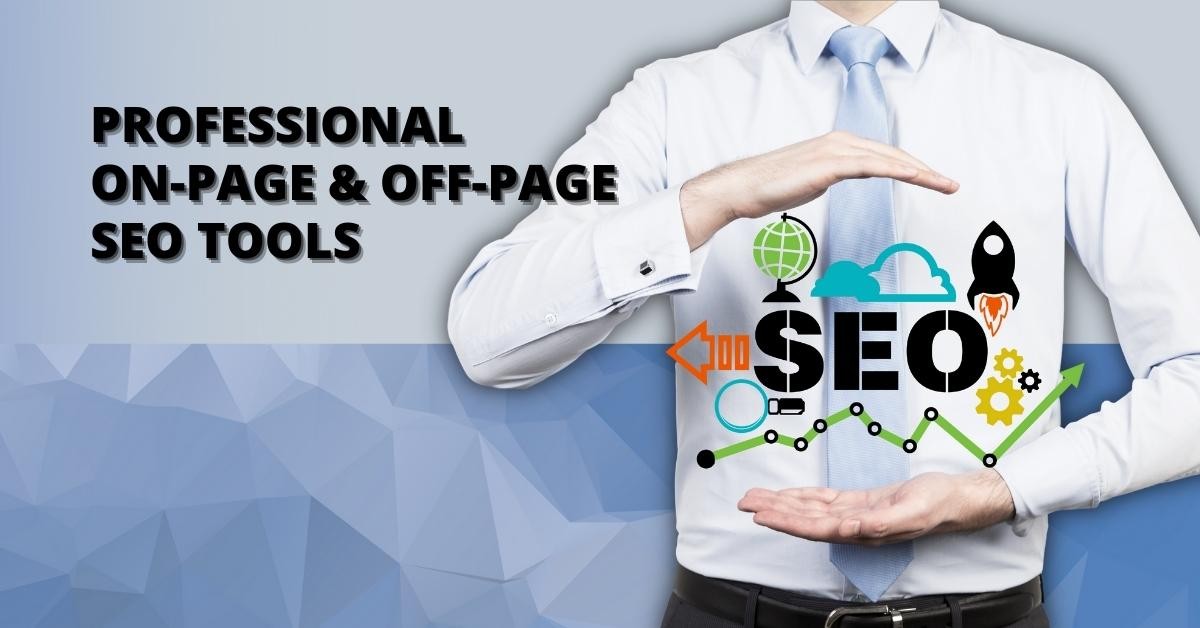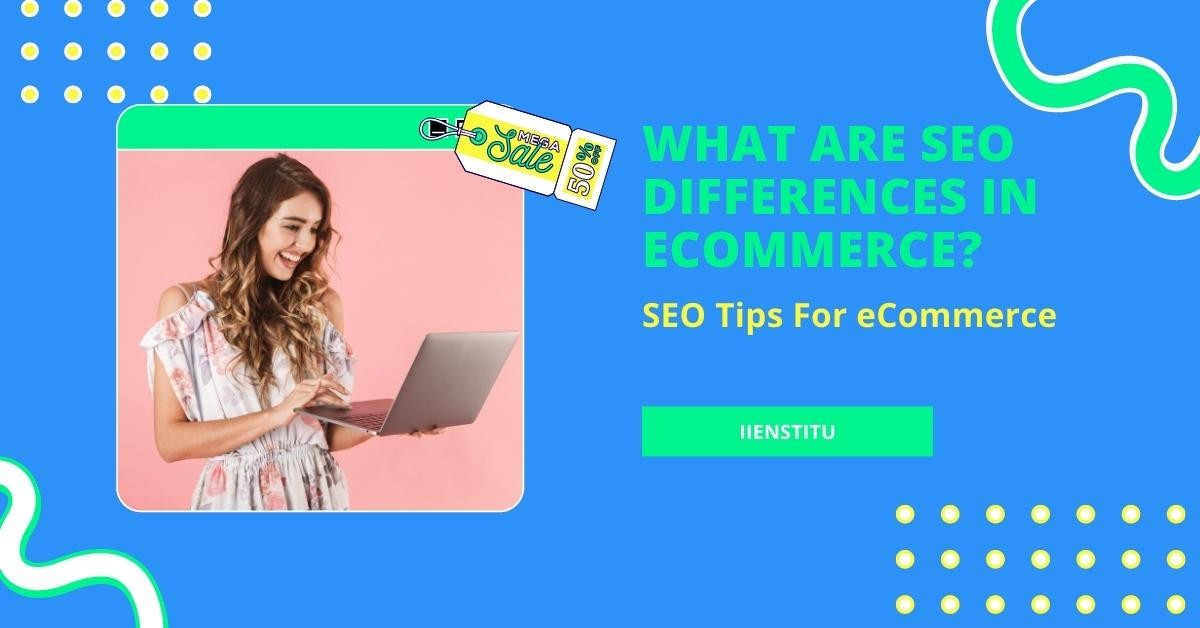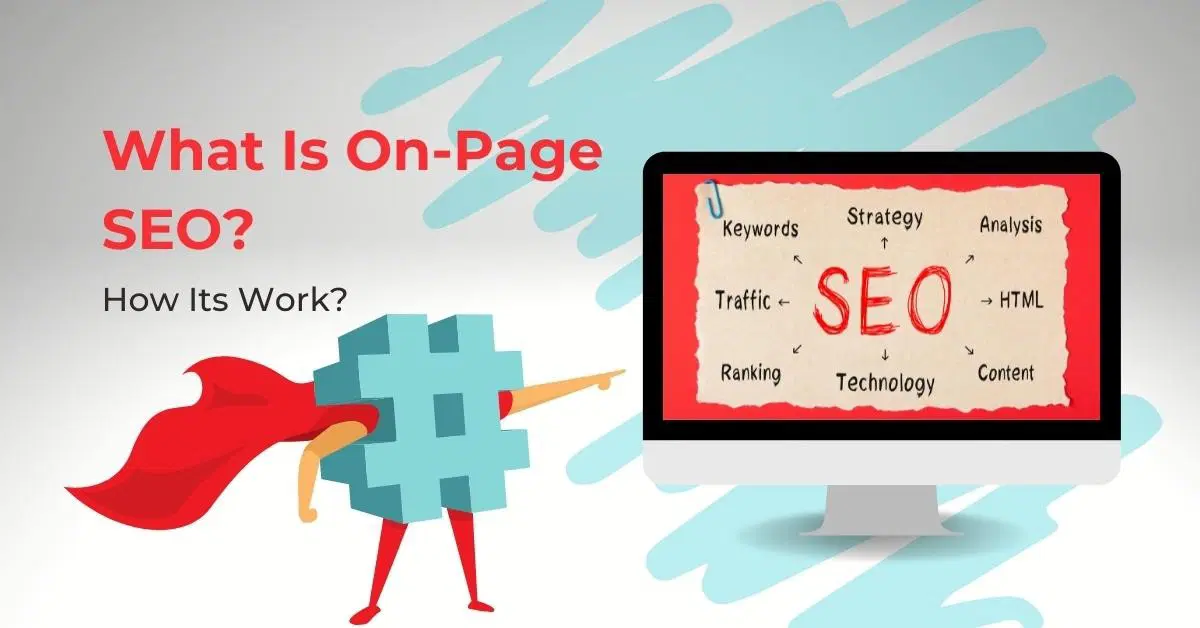
On-page SEO is a set of actions you can take to rank higher on search engines. Many things contribute, but the most important aspect for ranking well in Google or Bing results pages (SERPs) is optimizing content with keywords and phrases relevant to your business's topic.
Many different factors contribute to good on-page SEO. However, the most critical elements are:
1. Keyword Research: Identifying the right keywords and phrases to target is essential for on-page optimization. You need to find terms relevant to your business and have a high search volume.
2. Content Optimization: Once you have the keywords identified, you need to create content that uses those terms naturally and in a way that both readers and search engines easily find.
3. User Experience: The best on-page optimization strategies won't amount to much if users find what they are looking for when they visit your website. Ensure that your website is easy to navigate and that the content is engaging and helpful.
4. Technical Optimization: There are several technical elements that you can tweak on your website to improve your rankings in SERPs - things like titles, metatags, and anchor text.
Internal Linking: Using your internal links correctly can effectively guide users through your website and give them what they are looking for.
Site Speed: Search engines favor fast-loading websites, but it's not just about speed - you also need to make sure that everything on your site is optimized to load quickly.
7. Mobile Optimization: Now more than ever, it is vital to have a website that looks great and functions well on mobile devices. Mobile optimization is a must for any business looking to rank high in SERPs.
On-page SEO can seem like a daunting task, but if you take it one step at a time and focus on the most critical elements, you can see positive results in no time.
Why Should You Care About On-Page Seo?
On-page SEO is one of the most important aspects of search engine optimization. This means optimizing your website so that Google can find it and rank you higher on their search engine results pages (SERPs). On the page, changes have been seen as recent updates to help increase ranking, but there are offsite factors too, such as social media integration which allows with brand awareness, among other things.
5 Reasons To Care About On-Page SEO:
1. You want your website to show up as high as possible in the search engine rankings so that you can get more web traffic and potential customers.
2. Your website's content reflects your business - quality content will help you build trust with your audience.
3. On-page SEO is one of the many factors that search engines consider when ranking websites.
4. If any of your website's pages are not optimized, then you're missing out on a lot of potential traffic and customers.
5. Your website's user experience is essential to search engines, too, so optimizing your website will give you an advantage over your competitors who are not optimized for SEO.
SEO is essential for website optimization to rank higher on search engine results pages. Many on-page factors contribute to ranking, such as quality content, metadata, title tags, etc. Therefore, optimizing your website's pages for the best possible order is essential.
So, if you want to rank higher in the search engine results pages, you need to make sure all of your website pages are optimized. This will increase web traffic and potential customers. Not only that, but it also gives off an excellent impression to search engines and users alike.
Finally, you should care about on-page SEO because having quality content, metadata, title tags, etc., will help build trust with your audience. Trust is essential for building lasting relationships with customers and web users. With all these factors combined, you will rank higher in search engine results pages (SERPs) and boost traffic, revenue, etc.
How To Do On-Page SEO?
Step 1: Title Tag
The title tag is the most crucial on-page SEO factor. The text appears in the search engine results pages (SERP) as the blue link. Therefore, it should be descriptive and include your target keywords.
Step 2: Description Tag
The description tag is the text that appears under the title tag in the SERP. It should be descriptive and include your target keywords.
Step 3: Header Tags
Header tags are an important on-page SEO factor. They help structure your content and make it easy for search engines to understand.
Your content should be rich and engaging to entice your users. This will also help your rankings, as longer content tends to rank better in search engines.
Step 4: Anchor Text
Step 5: Image Optimisation
Image Optimisation is an important on-page SEO factor. You should use descriptive alt tags that include your keywords.
Step 6: Page Loading Speed
Your website's loading speed is a factor that search engines consider when ranking your website. Multiple studies have proved this. For example, Google's Page Speed tests show that the site with the fastest loading time ranks best.
Step 7: UX Design
Keep it simple and easy for users with no technical knowledge to be able to explore every part of your site quickly by clicking around; remove noise from keywords or phrases so they stand out more than ever before instead of just passing through unnoticed like background music at an airport while you're trying not to lose sleep over what might happen next because there are too many unknown factors.
These are the seven most crucial on-page SEO factors. You can improve your website's rankings on search engine results pages by following these steps.
On-page SEO tips:
When it comes to on-page SEO, page titles are a fundamental component of a successful SEO strategy. The title should be no more than 60 characters in length and contain keywords that will be most relevant to the page's content, and associate the page with the keywords it is targeting.
You want to make sure that the title is exciting and informative to users. A dull or uninformative title will not do your page any favors to attract clicks from users.
Additionally, it's crucial to include your targeted keywords in the title tag, but you don't want to go overboard. Excessive keyword stuffing can result in a title tag that complies with the rules but doesn't make sense to users. That might lead users to avoid clicking on the result and go somewhere else.
If you're struggling with finding your keywords in your page content and incorporating them into your titles, there are tools available that can help you out. One such tool is the Google AdWords Keyword Planner. This tool will help you find keywords related to your business and determine how competitive they are for targeting.
Another critical on-page SEO element is the header tag (H1, H2, H3, etc.). Header tags help break up your content into easily digestible chunks. Not only are they essential for readability, but Google also uses them to determine which content is most important on the page.
You don't want to stuff your keywords into header tags, either. Just like you would with titles, it's best to weave in keywords naturally throughout your content rather than force them in where they aren't needed.
Finally, you'll also want to make sure that your site is mobile-friendly. With the increasing number of people using smartphones and tablets to access the Internet, it's more important than ever to have a website that looks good and functions properly on mobile devices. Google has even begun penalizing sites that are not mobile-friendly, so it's essential to take this matter seriously.
SEO is a complex and ever-evolving field, but you can ensure that your website is optimized for success! And if you want to learn this critical field, you can join the SEO course for free!
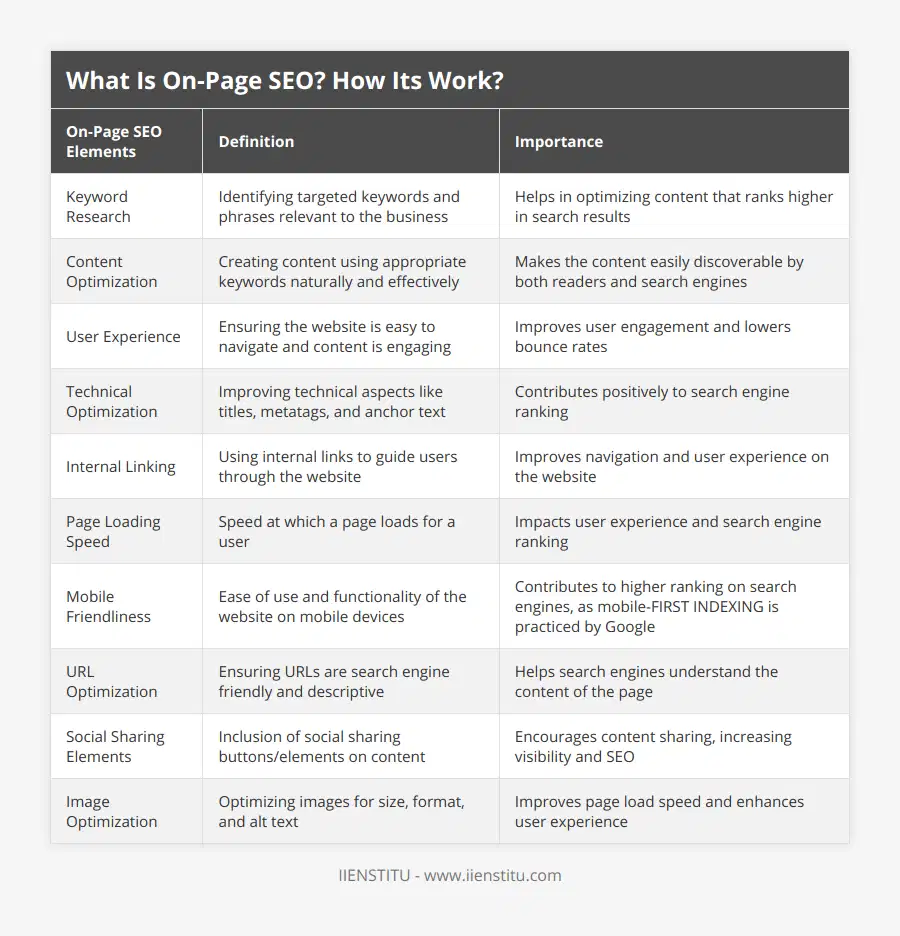
Frequently Asked Questions
What differentiates on-page SEO service from other SEO strategies?
On-Page SEO: A Unique Approach
SEO or Search Engine Optimization involves various strategies to improve the visibility and ranking of a website on search engine result pages. Among these strategies, on-page SEO service is an indispensable and distinct tactic that revolves around optimizing individual webpages to achieve higher rankings and drive more relevant traffic to the website.
Essential Elements of On-Page SEO
On-page SEO service primarily focuses on three key elements: content, HTML source code, and webpage architecture. For the content, it is crucial to conduct keyword research and incorporate relevant keywords strategically throughout the text. Optimizing title tags, meta descriptions, and headings (H1, H2, H3, etc.) is also an essential aspect of content optimization. Additionally, creating user-friendly and informative URLs plays a significant role in strengthening on-page SEO.
In terms of the HTML source code, on-page SEO concentrates on proper structuring and labeling of webpage elements (tags) for better search engine understanding. Employing schema markup or structured data to provide detailed information about the webpage content helps search engines display rich snippets, directly improving the click-through rate.
Lastly, as for the webpage architecture, on-page SEO ensures optimal user experience. This includes improving site speed by optimizing images, minifying code (CSS, JavaScript, and HTML), and using browser caching. Moreover, implementing correct navigation and internal linking structures is vital in ensuring search engine spiders can easily crawl and index the website.
Comparison with Other SEO Strategies
Unlike on-page SEO service, other SEO strategies, such as off-page and technical SEO, place more emphasis on activities that occur outside the website. Off-page SEO primarily involves link building through guest blogging, social media marketing, influencer outreach, and other tactics. The primary objective of off-page SEO is to establish website authority, trust, and online presence.
On the other hand, technical SEO deals with optimization processes that ensure search engines can crawl, index, and interpret a website effectively. Technical SEO employs activities such as sitemap creation, Robots.txt file implementation, canonicalization, and fixing broken links. This form of SEO is more concerned with improving the backend structure and infrastructure of the website.
In conclusion, while other SEO strategies focus on establishing authority and optimizing backend infrastructure, on-page SEO service emphasizes enhancing individual webpage aspects. By optimizing content, HTML source code, and webpage architecture, on-page SEO service ensures higher rankings and more relevant traffic to the website in the long run. Thus, it is a crucial tactic that distinguishes itself from off-page and technical SEO strategies.
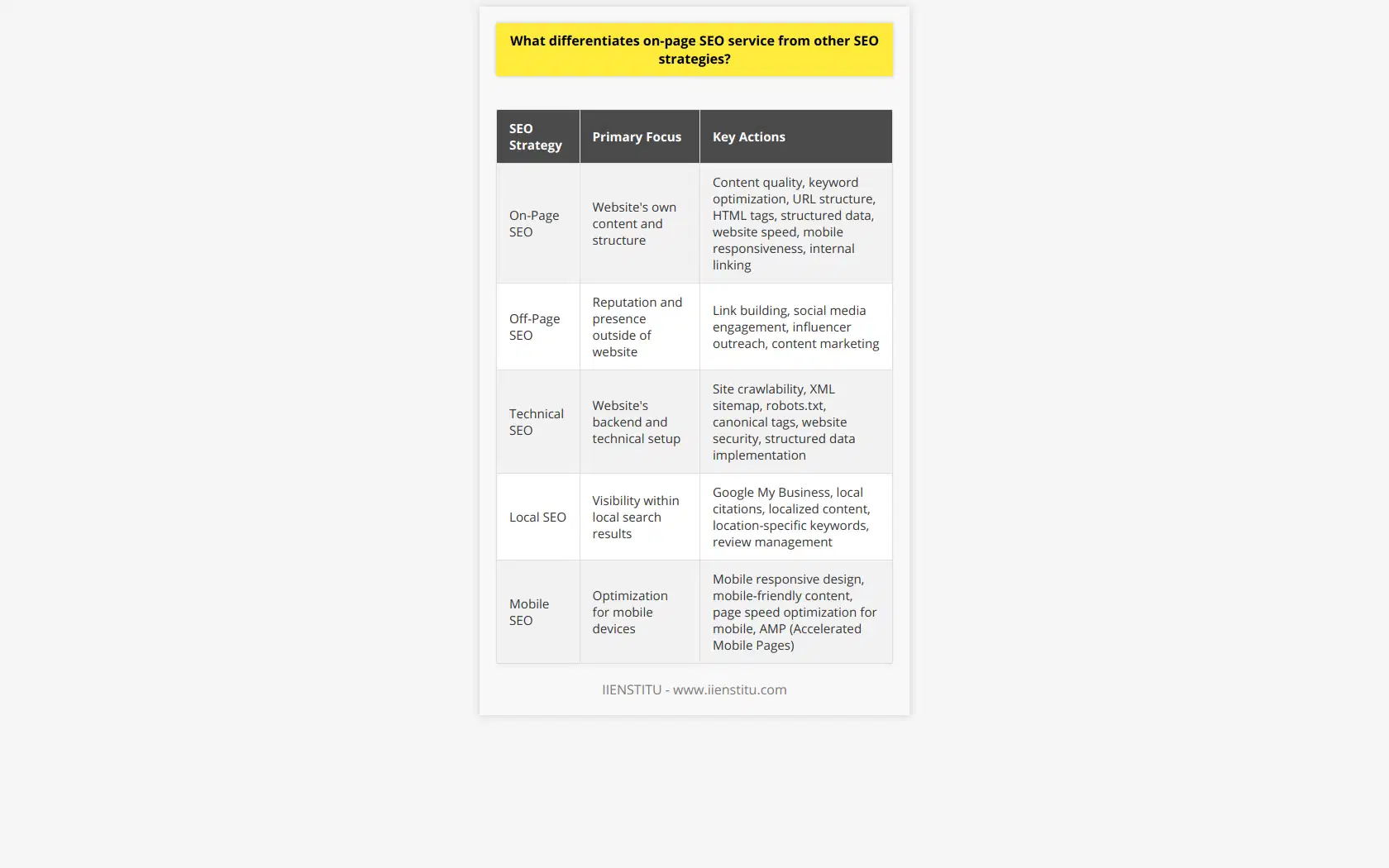
How do on-page SEO and off-page SEO impact the overall search engine optimization process?
On-page SEO and off-page SEO: Key Elements of Search Engine Optimization Process
On-Page SEO Significance
On-page SEO plays a vital role in improving a blog post's visibility on search engine results pages (SERPs). Targeting relevant keywords, incorporating them strategically in the content, title, and meta tags can enhance a post's searchability. Moreover, optimizing images, maintaining proper header tags hierarchy, and ensuring responsive web design also positively impact the overall SEO process.
User Experience and Engagement
Apart from technical aspects, on-page SEO also focuses on delivering a satisfying user experience. Readability, content structure, and internal linking contribute to better user engagement, which in turn leads to increased dwell time and a decreased bounce rate. Search engines consider these factors while ranking a webpage, making user experience an essential part of on-page SEO.
Off-Page SEO Importance
Off-page SEO entails external factors that influence a blog post's ranking on SERPs, building credibility in the eyes of search engines. High-quality backlinks, from relevant and authoritative websites, signal a vote of confidence in the content, leading to an improved domain authority.
Social Media Presence
A strong social media presence can significantly impact off-page SEO. Sharing content on popular platforms increases the chances of generating social signals (likes, shares, comments), which have a positive correlation with higher search engine rankings. Furthermore, social media helps in driving referral traffic, resulting in better overall SEO performance.
Interrelationship Between On-page and Off-page SEO
Although distinct, both on-page and off-page SEO are indispensable constituents of the search engine optimization process. Stellar on-page optimization not only attracts organic traffic but also enables search engine spiders to crawl and index webpages easily. With a sound technical base, off-page SEO helps to build a domain's authority and reputation, further enhancing its visibility.
To sum up, on-page and off-page SEO act as complementary forces in boosting a blog post's search engine rankings. A harmonious integration of these elements can lead to higher organic traffic and increased online visibility, contributing to the overall success of a blog or website.
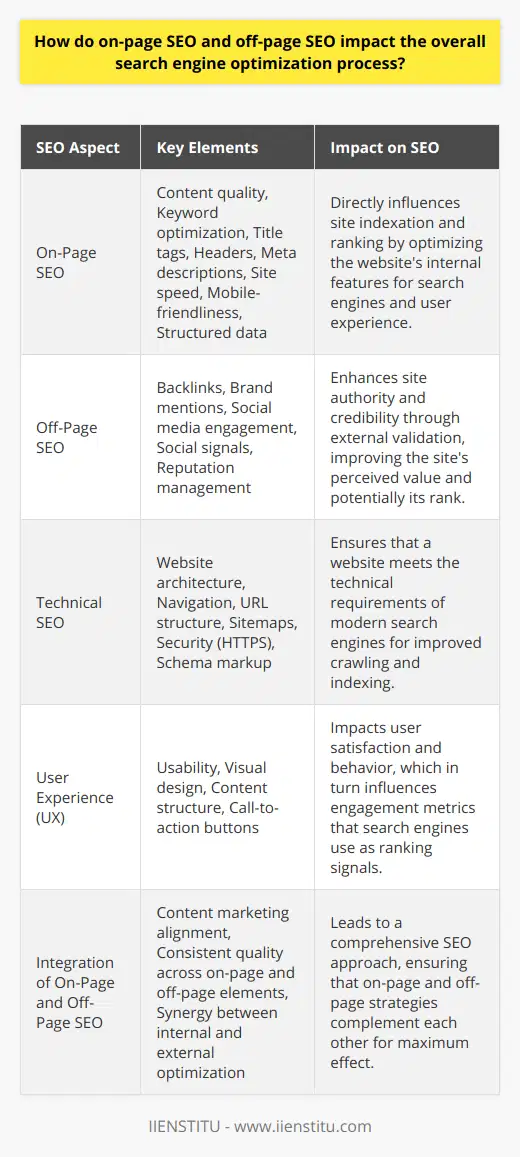
In the context of website development, how crucial is the implementation of on-page SEO techniques?
Significance of On-page SEO Techniques
In the realm of website development, implementing on-page Search Engine Optimization (SEO) methods proves to be highly critical for multiple reasons. First and foremost, these techniques directly influence the visibility of a website on search engine results pages (SERPs) by optimizing individual web pages to rank higher and attract more relevant traffic. On-page SEO is essential because it not only enhances the user experience and site structure, but also improves the website's credibility and relevance by primarily focusing on content quality and technical aspects.
Impact on User Experience
A crucial aspect of on-page SEO is incorporating user-friendly navigation and accessible information, thereby enhancing the overall experience for website visitors. By ensuring that content is easy to locate and providing clear, concise information with relevant images and headings, website developers can improve user satisfaction and increase the likelihood of repeat visits, leading to improved rankings on search engine platforms such as Google.
Site Structure Optimization
Another significant aspect of on-page SEO is optimizing the site’s structure, which includes URL compatibility, mobile responsiveness, loading speed, and internal linking. When developers create logical and easy-to-understand URL structures, it allows search engines to crawl and index the content efficiently. Additionally, by focusing on speed and mobile responsiveness, they aim to reduce bounce rates and improve the time users spend on the website, which indirectly contribute to better rankings on SERPs.
Content Quality Enhancement
The implementation of on-page SEO techniques also involves creating high-quality, engaging, and informative content that adheres to search engine guidelines. This includes keyword optimization, which ensures the appropriate integration of relevant keywords within the content. Additionally, employing original and regularly updated content, free from plagiarism, enhances the website’s reputation, making it more appealing to both users and search engines.
Technical Aspects
Lastly, on-page SEO techniques involve addressing technical elements, including title tags, meta descriptions, and header tags, ensuring that they are customized and optimized for the targeted keywords. This assists in providing further clarity to search engines, helping the website rank higher on relevant SERPs.
In conclusion, the implementation of on-page SEO techniques is vital in website development as it plays a significant role in improving a website's visibility, user experience, and credibility. By optimizing various aspects such as content quality, site structure, and technical elements, on-page SEO serves as an indispensable factor in achieving higher rankings on search engine result pages and attracting more organic traffic.
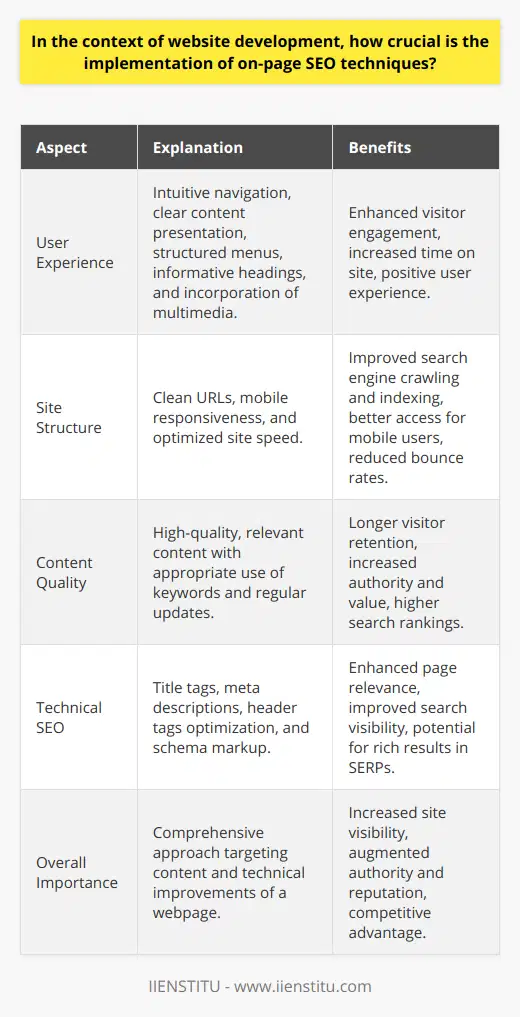
What is the difference between SEO and on-page SEO, and how do they complement each other?
Defining SEO and On-Page SEO
Search Engine Optimization (SEO) refers to the process of enhancing a website's visibility and ranking on search engine results pages (SERPs) using organic, non-paid tactics. Among the various components of SEO, on-page SEO holds significant importance, as it involves optimizing various elements present on individual web pages of a site, such as title tags, headings, URLs, and images. The primary difference between SEO and on-page SEO lies in their scope, with the former encompassing a broader range of strategies, while the latter focuses on individual web pages.
Complementary Nature of SEO and On-Page SEO
Despite the distinction between the two concepts, SEO and on-page SEO complement each other by working together to improve a website's overall online presence, which directly impacts search engine rankings.
Importance of On-Page SEO in the SEO Process
On-page SEO contributes to the overall SEO strategy by optimizing elements directly related to the content and structure of web pages. This enhances the relevance and accessibility of pages, making it easier for search engines to crawl, index, and rank them. By addressing on-page factors like meta tags and content quality, on-page SEO ensures that a site's pages align with search engine algorithms and user intent, thus increasing the likelihood of ranking higher in search results.
Role of Off-Page SEO in Complementing On-Page SEO
While on-page SEO focuses on the individual elements of a site, off-page SEO employs strategies that involve external factors, such as backlinks, social media signals, and online reputation management. By combining on-page and off-page SEO efforts, a comprehensive SEO strategy targets both the technical and external elements influencing a website's search engine rankings. This holistic approach facilitates a synergistic relationship between the two components, amplifying the effectiveness of each to drive sustainable results.
Conclusion
In summary, the key difference between SEO and on-page SEO concerns their respective areas of focus: while the former addresses a broad range of tactics aimed at improving a site's online presence and visibility, the latter specifically targets those optimization techniques applicable to individual web pages. Despite these differences, SEO and on-page SEO ultimately complement each other by combining their specific strengths, thereby maximizing the benefits of both approaches to achieve higher search engine rankings and increased website traffic.
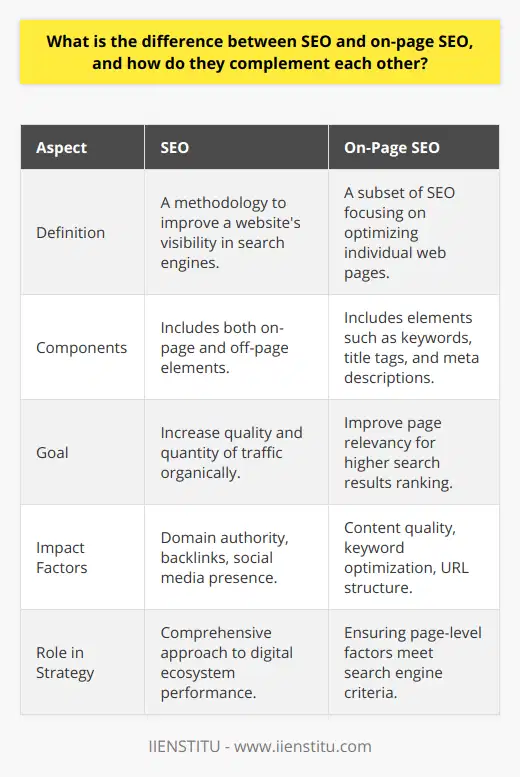
Can you provide specific examples of on-page SEO techniques and their potential benefits for a website?
Keyword Placement and Density
One effective on-page SEO technique for blog posts is the strategic placement of keywords throughout the content. This includes the title, headings, subheadings, and the first and last paragraphs of text. Such placement helps search engines better understand the topic and relevance of the content, leading to improved search rankings.
Title Tags and Meta Descriptions
Another on-page SEO technique is the optimization of title tags and meta descriptions. Title tags serve as the headline of the blog post in search engine results, while meta descriptions are the summary of the post's content. By accurately and concisely describing the content, these elements can attract clicks from users and increase the page's visibility.
Internal Linking
Bloggers can also enhance on-page SEO by integrating internal links within their content. Connecting related articles within the blog encourages visitors to spend more time on the site, addressing an important factor for search engine rankings. This can result in a more meaningful user experience, as it makes navigation more seamless.
Image Optimization
Using relevant images in blog posts with descriptive file names and alt attributes can also boost on-page SEO. Search engines use these attributes to understand images and index them accordingly. Optimized images can contribute to higher rankings in image search results, and they can enhance overall user engagement with the content.
URL Structure
Lastly, maintaining a clean and descriptive URL structure can improve a blog's on-page SEO. URLs that include targeted keywords and clearly represent the content can signal to both users and search engines the relevance and context of the post. This can lead to increased click-through rates and better visibility in search rankings.
In summary, employing a combination of on-page SEO techniques, such as strategic keyword placement, title tag and meta description optimization, internal linking, image optimization, and a clean URL structure can yield significant benefits for a blog's search engine visibility and user experience. These techniques contribute to the overall success of a website by attracting more organic traffic and fostering better user engagement.
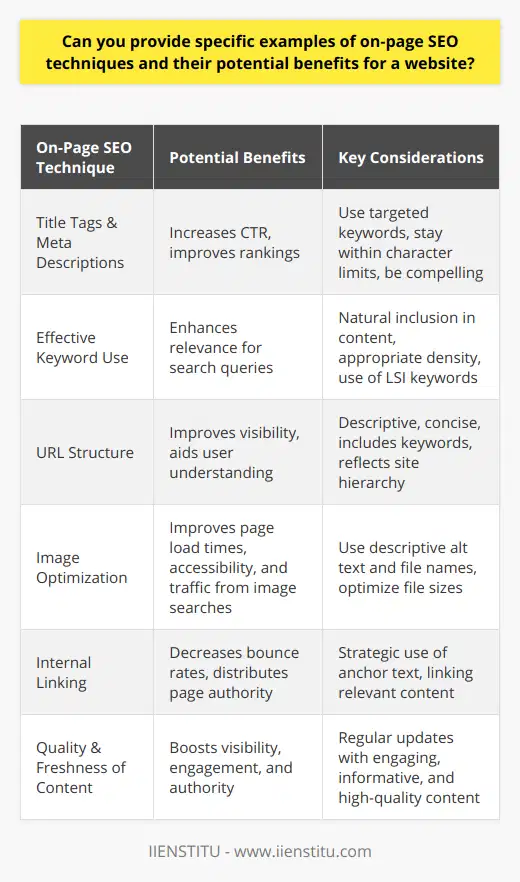
In the context of optimizing a website for search engines, what essential on-page SEO factors should be prioritized, and why?
On-Page SEO Factors
Keyword Integration
Integrating relevant keywords into a website's content is crucial for optimizing search engine rankings. This allows search engines to comprehend the website's focus, thus making the content more discoverable by users seeking those specific terms.
Title Tags
Creating an accurate and engaging title tag for each web page is essential, as search engines prioritize these when ranking content. Title tags convey the main subject of the page, enticing users to click on the link in search results.
Meta Descriptions
Crafting informative and concise meta descriptions is critical since they provide potential visitors with an overview of a webpage's content. This brief summary entices users to visit the page, improving the site's overall click-through rate.
Headers
Structuring content with appropriate header tags (H1-H6) contributes to website optimization. Headers not only improve user experience by organizing content into easily digestible sections, but they also help search engines understand the hierarchy and flow of information on a page.
Image Optimization
Optimizing images by compressing file size and adding relevant alt tags is highly important. This ensures faster load time, which increases user engagement and improves search rankings, while also providing search engines with additional context about the site's content through the alt tags.
URL Structure
Utilizing simple, descriptive URLs that incorporate targeted keywords is beneficial for both users and search engines. Easily readable URLs facilitate user navigation and help search engines interpret page relationships, which both contribute to higher ranking in search results.
Internal Linking
Effectively employing internal links within website content benefits SEO by creating a connected network of topics. This streamlines the site's navigation for users and search engines, enabling better indexation of content and providing opportunities for additional user engagement.
In conclusion, prioritizing these on-page SEO factors in a strategic and cohesive manner plays an integral role in improving a website's visibility in search results. Implementing these practices ensures that both users and search engines can access, understand, and appreciate the website's content, ultimately bolstering its search ranking.
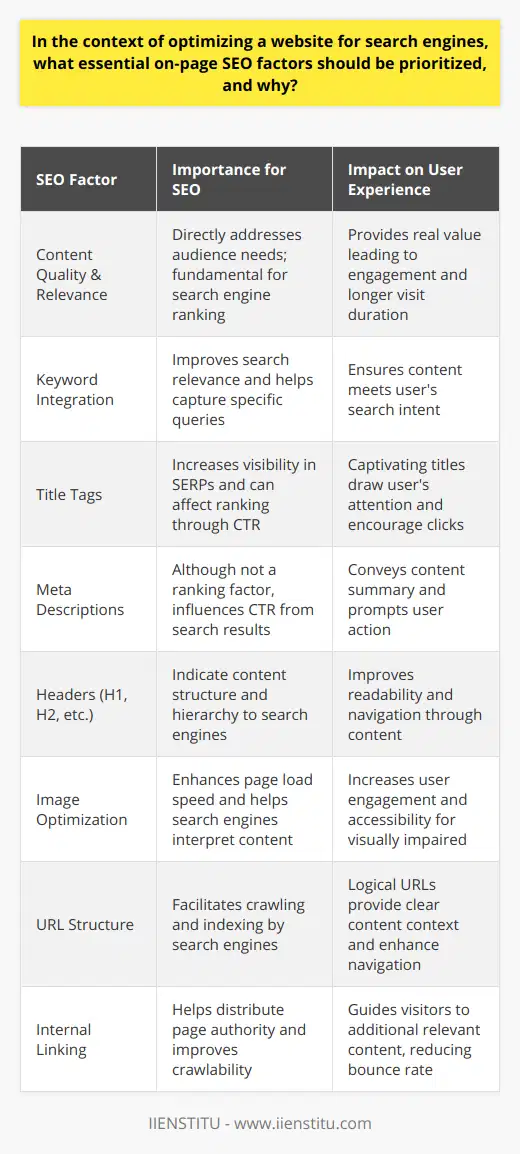
What is the significance of incorporating on-page SEO for a website's overall visibility and search engine ranking?
Impact of On-Page SEO on Visibility and Ranking
Essential Role in Website Visibility
Integrating on-page SEO strategies plays an essential role in enhancing a website's overall visibility, which refers to the prominence of a webpage on search engine result pages (SERPs). Effectively optimizing elements such as title tags, meta descriptions, headers, and keyword usage within the content ensures that search engines understand the purpose and relevance of the webpage, ultimately increasing its chances of appearing higher on SERPs.
Direct Influence on Search Engine Ranking
On-page SEO directly impacts search engine ranking, the position where a webpage appears on SERPs for specific keywords or phrases. The primary goal of search engines is to provide users with the most relevant and valuable content based on their queries. By employing on-page optimization techniques, webmasters can effectively convey the content's relevance to specific search terms, leading to improved search engine rankings.
Enhanced User Experience
An often overlooked aspect of on-page SEO is its ability to improve the overall user experience, a critical factor in determining search engine rankings. Ensuring relevant and valuable content delivery, logical content organization, and proper formatting not only makes a page more appealing to users but also provides search engines with essential information regarding the webpage's utility. Consequently, well-optimized on-page SEO strategies can contribute to higher user engagement metrics, which indirectly influence search engine rankings.
Improved Website Crawlability
Lastly, on-page SEO implementation is significant in ensuring the crawlability of a website. Crawlability refers to a search engine's ability to access and index webpages for inclusion in their search results. By employing proper on-page optimization practices, such as relevant URL structures, internal linking, and mobile-friendliness, webmasters can facilitate the crawling process, allowing search engines to efficiently index their pages and subsequently increase overall visibility and rankings.
In summary, incorporating on-page SEO strategies is of paramount importance in determining a website's overall visibility and search engine ranking. By effectively addressing vital on-page elements, webmasters can significantly increase their chances of achieving higher SERP positions and ultimately improving their online presence.

How do on-page SEO techniques ensure content relevancy and improve user experience?
On-Page SEO Techniques and Content Relevancy
Effective use of on-page SEO techniques ensures that content is relevant and user experience is optimized. These techniques incorporate a variety of factors, such as keywords, meta tags, headers, and optimized images, which work together to improve the visibility of content in search engine results.
Keyword Usage and Placement
Incorporating targeted keywords throughout the blog content is crucial for improving online visibility. Using these keywords strategically in titles, headings, subheadings, and the opening and closing paragraphs of the article ensures that both users and search engine algorithms can quickly understand the content's main topics. The objective is to provide accessible information for users, while also demonstrating relevance to search engines.
Meta Tags and Descriptions
Meta tags, including title tags and meta descriptions, help search engines understand the content and display accurate information for users. A well-written, keyword-rich title tag and meta description increase the likelihood of users clicking on the blog post. Additionally, an accurate and concise description improves user experience by allowing readers to understand the contents of the page before clicking on the link.
Headers and Formatting
Using headings and subheadings in blog content enhances readability and navigation. Structuring content with appropriate header tags (e.g., H1, H2, H3) creates a visual hierarchy for the information provided, which allows users to scan the content efficiently and locate the information they seek. Proper formatting also helps search engine algorithms to understand the importance and context of various sections within a piece of content.
Optimized Images and Multimedia
Integrating images and multimedia elements, such as videos, can improve user experience by providing a visual representation of the content. However, it is essential to optimize these elements by adding descriptive alt text, using appropriate file formats, and compressing the images to minimize loading times. This not only ensures a positive experience for users but also contributes to SEO performance as search engines consider page loading speed when ranking content.
In conclusion, implementing on-page SEO techniques helps to ensure content relevancy and enhance user experience by structuring and presenting information effectively. Adequate keyword usage, well-written meta tags, organized headers and formatting, and optimized images and multimedia elements serve as essential components in delivering high-quality and relevant content to users while simultaneously improving search engine rankings.
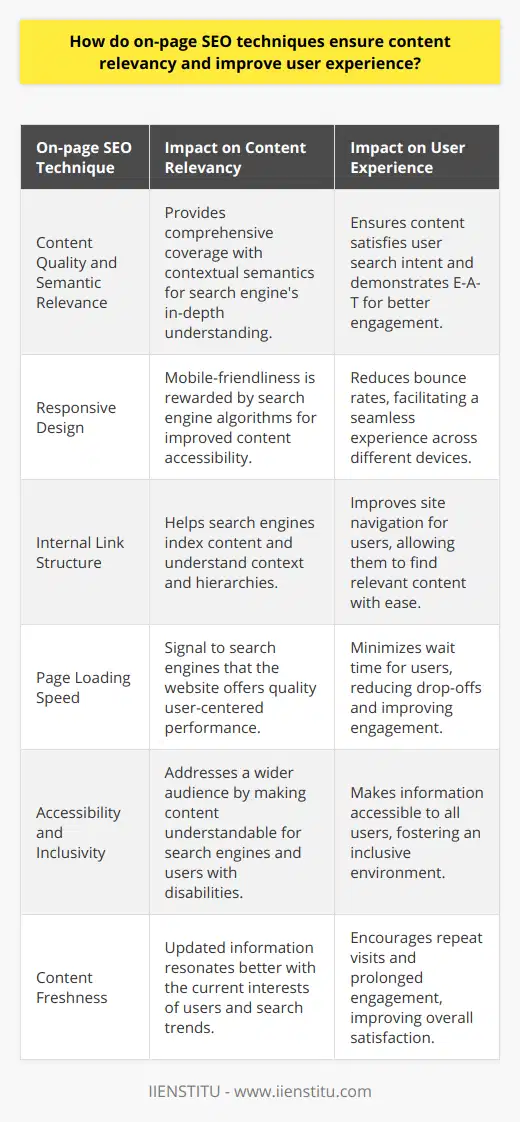
What are some potential limitations or challenges associated with relying solely on on-page SEO for a website's search engine performance?
Limited Effectiveness
One major challenge associated with relying solely on on-page SEO for a website's search engine performance is its limited effectiveness. On-page SEO only addresses the content and structure of a website, which is just one aspect of optimizing a website's search engine ranking. Search engines, like Google, consider numerous factors beyond the content itself when assigning rankings to websites.
Ignoring Off-page SEO Factors
By focusing exclusively on on-page SEO, marketers may neglect important off-page SEO factors, such as the number of quality backlinks pointing to their website. Backlinks act as endorsements, signaling to search engines that the content is valuable and deserving of a higher rank in search results. A lack of off-page SEO efforts can result in fewer backlinks and a lower search engine ranking, even if the on-page SEO is well-executed.
Dynamic Search Engine Algorithms
Another limitation is the constantly changing landscape of search engine algorithms. These algorithms are updated frequently, meaning that the on-page SEO tactics that work well today may be less effective tomorrow. Relying solely on on-page SEO for a website's search engine performance can lead to complacency in monitoring and adapting to these changes, negatively impacting search engine rankings.
Keyword Competition
In highly competitive niches, targeting popular keywords through on-page SEO may not be sufficient on its own to achieve high search engine rankings. Websites with a stronger overall web presence, such as a greater number of quality backlinks and social media shares, may outperform a website with sound on-page SEO strategies in contentious markets, due to the combined influence of off-page SEO factors.
Missed Opportunities for Diversification
Exclusively focusing on on-page SEO also limits a website's reach to potential audiences. In contrast, a comprehensive digital marketing strategy that includes off-page SEO, social media, and paid advertising efforts is likely to be more effective in reaching a wider audience and improving overall search engine performance.
In conclusion, while on-page SEO is a crucial element of optimizing a website's search engine performance, relying solely on this approach presents several limitations and challenges. To achieve the best possible search engine rankings, marketers should adopt a comprehensive, multi-faceted digital marketing strategy that combines both on-page and off-page SEO efforts, alongside other marketing channels.


